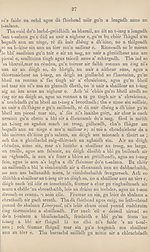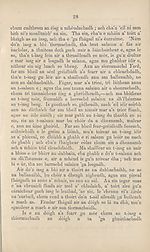Books and other items printed in Gaelic from 1841 to 1870 > Seol air an glacar agus an gréidhear an sgadan, agus air an gréidhear an trosg, an langa, a traille, agus am falmair
(60) Page 28
Download files
Complete book:
Individual page:
Thumbnail gallery: Grid view | List view

28
to increase the weight of fish, hut nothing is more falla¬
cious,—not only is the sap thus extracted, and the fish
made lighter, but, as the drying advances, they become
encrusted with salt, which falls off at every handling,
whilst the fish are so much deteriorated, as to he rejected
as salt-burned, or taken at a very reduced price. In
Yorkshire, where the mode of cure is such as to produce
the most perfect article, the whole of the fish are salted
in tubs or vats, three days being generally allowed them
to remain in salt, and one ton of salt is allowed to cure
three tons of fish,—but if the fish are large, more salt will
be required than if they are smaller. This is a difficult
matter to manage where the climate is damp, for if the
season happens to be wet, and the fish do not receive a
sufficient quantity of salt, they will soon get mi ted. The
knowledge of their having taken in a sufficient quantity
of salt, so as to be enough cured in that respect, whether
they are yet too soft, must be obtained by the grip of the
hand of an experienced Curer, before they are taken out
of the pickle. If the fish be salted when fresh off the
hook, they will take in no more salt than will perfectly
cure them, however much may be given them ; but if
they are not fresh, by giving them too much salt they
will get salt-burned.
After the fish are drawn from the vats, they should
be well washed, and the pickle brushed out in the sea,
or in sea water, and then they must be built up in a long
pile on a stony beach, taking care that each fish is placed
in a sloping direction, that is to say, with its head higher
than its tail, so as to allow the salt water to be well
dripped out of them. They may remain in this state
for a day or two before they are laid out for the purpose
of drying.
By far the best mode of drying the fish is that prac-
to increase the weight of fish, hut nothing is more falla¬
cious,—not only is the sap thus extracted, and the fish
made lighter, but, as the drying advances, they become
encrusted with salt, which falls off at every handling,
whilst the fish are so much deteriorated, as to he rejected
as salt-burned, or taken at a very reduced price. In
Yorkshire, where the mode of cure is such as to produce
the most perfect article, the whole of the fish are salted
in tubs or vats, three days being generally allowed them
to remain in salt, and one ton of salt is allowed to cure
three tons of fish,—but if the fish are large, more salt will
be required than if they are smaller. This is a difficult
matter to manage where the climate is damp, for if the
season happens to be wet, and the fish do not receive a
sufficient quantity of salt, they will soon get mi ted. The
knowledge of their having taken in a sufficient quantity
of salt, so as to be enough cured in that respect, whether
they are yet too soft, must be obtained by the grip of the
hand of an experienced Curer, before they are taken out
of the pickle. If the fish be salted when fresh off the
hook, they will take in no more salt than will perfectly
cure them, however much may be given them ; but if
they are not fresh, by giving them too much salt they
will get salt-burned.
After the fish are drawn from the vats, they should
be well washed, and the pickle brushed out in the sea,
or in sea water, and then they must be built up in a long
pile on a stony beach, taking care that each fish is placed
in a sloping direction, that is to say, with its head higher
than its tail, so as to allow the salt water to be well
dripped out of them. They may remain in this state
for a day or two before they are laid out for the purpose
of drying.
By far the best mode of drying the fish is that prac-
Set display mode to:
![]() Universal Viewer |
Universal Viewer | ![]() Mirador |
Large image | Transcription
Mirador |
Large image | Transcription
Images and transcriptions on this page, including medium image downloads, may be used under the Creative Commons Attribution 4.0 International Licence unless otherwise stated. ![]()
| Permanent URL | https://digital.nls.uk/109612642 |
|---|
| Description | Out-of-copyright books printed in Gaelic between 1631 and 1900. Also some pamphlets and chapbooks. Includes poetry and songs, religious books such as catechisms and hymns, and different editions of the Bible and the Psalms. Also includes the second book ever published in Gaelic in 1631. |
|---|

